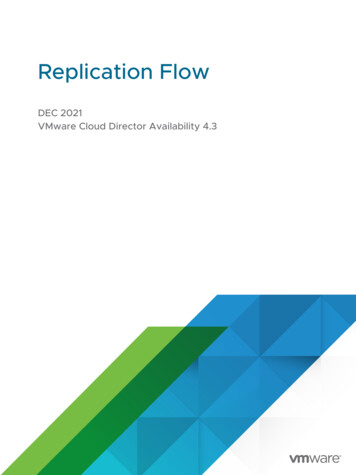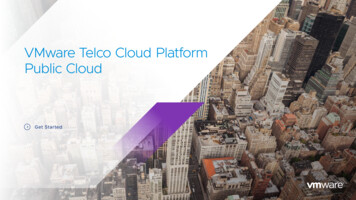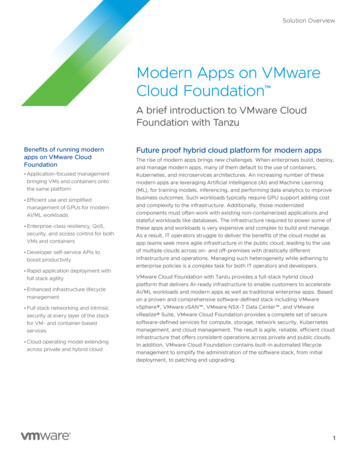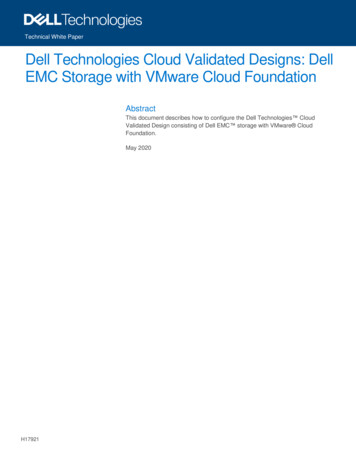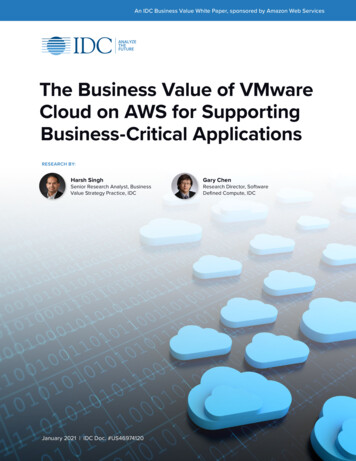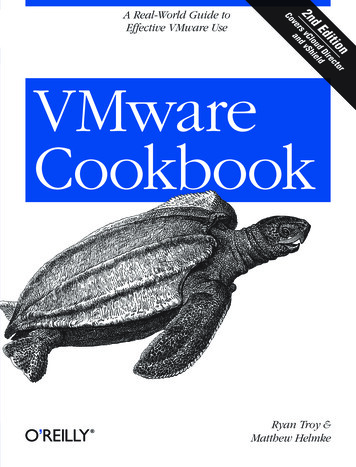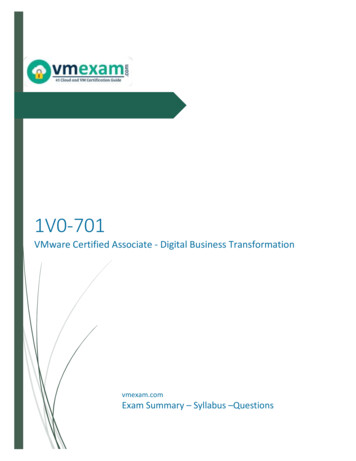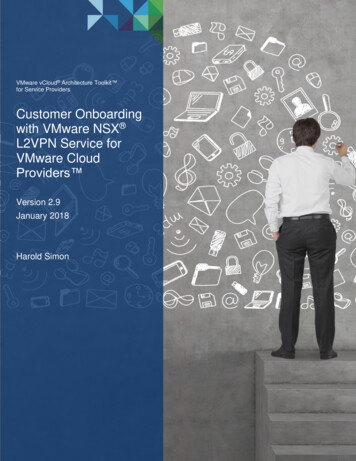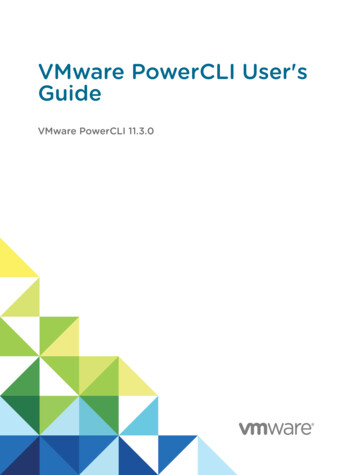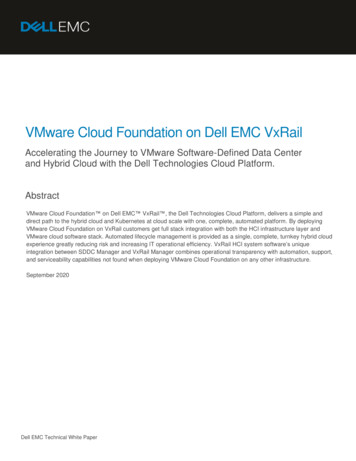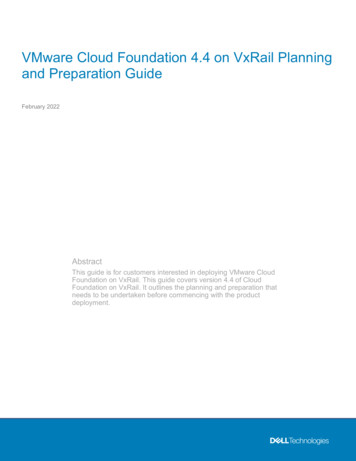
Transcription
VMware Cloud Foundation 4.4 on VxRail Planningand Preparation GuideFebruary 2022AbstractThis guide is for customers interested in deploying VMware CloudFoundation on VxRail. This guide covers version 4.4 of CloudFoundation on VxRail. It outlines the planning and preparation thatneeds to be undertaken before commencing with the productdeployment.
CopyrightThe information in this publication is provided as is. Dell Inc. makes no representations or warranties of any kind with respectto the information in this publication, and specifically disclaims implied warranties of merchantability or fitness for a particularpurpose.Use, copying, and distribution of any software described in this publication requires an applicable software license.Copyright 2022 Dell Inc. or its subsidiaries. All Rights Reserved. Dell Technologies, Dell, EMC, Dell EMC and othertrademarks are trademarks of Dell Inc. or its subsidiaries. Intel, the Intel logo, the Intel Inside logo and Xeon are trademarksof Intel Corporation in the U.S. and/or other countries. Other trademarks may be trademarks of their respective owners.Published in the USA 02/22 Planning Guide H18416.Dell Inc. believes the information in this document is accurate as of its publication date. The information is subject to changewithout notice.2VMware Cloud Foundation 4.4 on VxRail Planning and Preparation Guide
Executive SummaryContentsChapter 1 . Executive Summary7Solution description . 8Solution version reference . 8Document purpose . 8Intended audience . 8Revisions . 8Chapter 2 . VMware Cloud Foundation on VxRail10Product overview . 11Chapter 3 . VMware Cloud Foundation on VxRail Requirements and UseCases . 15Introduction . 16VMware Cloud Foundation on VxRail workload planning . 17VMware Cloud Foundation on VxRail deployment overview . 18Chapter 4 . VMware Cloud Foundation on VxRail Workload DomainPlanning 20Introduction . 21NSX-T management options for VI workload domain . 22vRealize software option for VI workload domains . 23vSphere with Kubernetes workload domains . 23Chapter 5 . Data Center and Network Requirements24Introduction . 25Data center rack space requirements . 25Data center networking. 25Network switch selection . 26Switch port capacity. 26Switch port type . 27Jumbo Frames. 27Multicast . 27Border Gateway Protocol . 27Hardware VTEP for multi-rack deployments . 28Network services . 28Storage Services . 29VMware Cloud Foundation 4.4 on VxRail Planning and Preparation Guide3
Executive SummaryChapter 6 . Cloud Foundation on VxRail High-Level Design31Introduction . 32Consolidated vs. standard architecture . 32Site locations . 33Application availability . 33VxRail cluster network planning . 34Chapter 7 . Cloud Foundation on VxRail Workload Planning40Introduction . 41Determine use cases for Cloud Foundation VI workload domain . 41Deciding on single-site VxRail cluster or stretched cluster . 41Planning the management workload domain resource requirements . 43Planning the VI workload domain resource requirements . 44Sizing the Cloud Foundation domains . 44Chapter 8 . Application Dependencies and Routing Decisions48Understanding connection dependencies . 49Chapter 9 . Cloud Foundation on VxRail Physical Network Planning52Introduction . 53Select a physical network architecture and topology . 53VxRail stretched cluster physical network planning . 55Fibre Channel storage network planning . 58Chapter 10 . Cloud Foundation on VxRail Physical Network Preparation60Introduction . 61Capture configuration settings for Cloud Foundation on VxRail . 61VxRail cluster and NSX-T networks leaf switch preparation . 61DHCP services for NSX-T host overlay network preparation . 63Leaf switch preparation for NSX-T edge . 65Layer 3 network preparation . 65BGP peering preparation . 67Chapter 11 . VxRail Cluster Deployment Preparation70Introduction . 71Prepare for VxRail cluster initial build . 71Select the external management network subnet . 71Select the VxRail cluster VLANs . 72Select the network settings for VxRail cluster . 72Decide whether to join an existing vCenter SSO domain . 73Select the network settings for VxRail stretched cluster . 73Create forward and reverse DNS entries for VxRail cluster . 734VMware Cloud Foundation 4.4 on VxRail Planning and Preparation Guide
Executive SummarySelect passwords . 73Chapter 12 . Prepare for VMware Cloud Foundation Management VIWorkload Domain74Introduction . 75Provide a temporary IP address for Cloud Builder . 75Select the settings for the management workload domain . 75Provide global settings for management VI workload domain . 75Select the settings for NSX-T host overlay network . 76Create forward and reverse DNS entries for the management VI workload domain. 76Select the NSX-T host overlay VLAN . 76Select names for resource pools in VI Management workload domain . 77Decide on number of virtual distributed switches . 77Prepare passwords. 78Obtain VMware license keys . 78Chapter 13 . Prepare for Cloud Foundation VI Workload Domain79Introduction . 80Cloud Foundation workload domain task outline . 80Prepare NSX-T host overlay network . 80Capture settings for VI workload domain. 81Prepare for vSphere for Tanzu workload domain . 81Prepare for multi-region with NSX-T Federation . 83Chapter 14 . Prepare for NSX-T Edge Gateway Services85Introduction . 86Capture external router settings for eBGP peering . 86Capture settings for NSX-T edge gateway uplinks . 86Capture NSX-T edge overlay network settings . 87Capture second site settings for stretched cluster . 87Chapter 15 . Prepare for Cloud Foundation Application Virtual Network89Introduction . 90Capture the Application Virtual Network region settings . 90Appendixes . 92Appendix A: Cloud Foundation on VxRail checklist . 93Appendix B: Cloud Foundation on VxRail footprints for sizing . 97Appendix C: Cloud Foundation on VxRail VLANs . 99Appendix D: VxRail network configuration . 100Appendix E: Cloud Builder and management VI workload configuration . 102Appendix F: VI workload domain configuration settings . 104VMware Cloud Foundation 4.4 on VxRail Planning and Preparation Guide5
Executive SummaryAppendix G: Edge Gateway configuration. 106Appendix H: Application Virtual Network configuration . 107Appendix I: Sample switch configuration settings . 1086VMware Cloud Foundation 4.4 on VxRail Planning and Preparation Guide
Executive SummaryChapter 1 Executive SummaryThis chapter presents the following topics:Solution description . 8Solution version reference . 8Document purpose . 8Intended audience . 8Revisions. 8VMware Cloud Foundation 4.4 on VxRail Planning and Preparation Guide7
Executive SummarySolution descriptionVMware Cloud Foundation (VCF) on VxRail is a Dell Technologies and VMware jointlyengineered integrated solution. It contains features that simplify, streamline, and automatethe operations of your entire Software-Defined Datacenter (SDDC) from Day 0 throughDay 2. The new platform delivers a set of software-defined services for compute (withvSphere and vCenter), storage (with vSAN), networking (with NSX), security, and cloudmanagement (with vRealize Suite) in both private and public environments, making it theoperational hub for your hybrid cloud.VCF on VxRail provides the simplest path to the hybrid cloud through a fully integratedhybrid cloud platform that leverages native VxRail hardware and software capabilities andother VxRail-unique integrations (such as vCenter plugins and Dell networking). Thesecomponents work together to deliver a new turnkey hybrid cloud user experience with fullstack integration. Full-stack integration means you get both HCI infrastructure layer andcloud software stack in one complete automated life-cycle turnkey experience.Solution version referenceThis guide supports the major software release 4.4 of VMware Cloud Foundation, andmajor software release 7.0 of VxRail. The specific versions of the software stacksupported for the major versions of VMware Cloud Foundation on VxRail covered in thisguide can be found in the VMware Cloud Foundation 4.x on VxRail Support Matrix.Document purposeThis guide provides detailed guidance for the initial deployment of a VCF on VxRailsolution in a data center. It outlines the tasks and processes that you should expect andprepare for from the planning and design phase through deployment of the solution. Theguide also serves as an aid in helping determine a configuration that meets your businessand operational objectives.Intended audienceThis planning and preparation guide is intended for cloud architects, network architects,and technical sales engineers who are interested in the planning, designing, anddeployment of the VCF on VxRail solution to meet business and operational requirements.Readers should be familiar with VMware vSphere, NSX, vSAN, and vRealize productsuites in addition to general network architecture concepts.Revisions8DateDescriptionApril 2019Initial releaseAugust 2019Updated to support VMware Cloud Foundation 3.8February 2020Updated to support VMware Cloud Foundation 3.9.1VMware Cloud Foundation 4.4 on VxRail Planning and Preparation Guide
Executive SummaryDateDescriptionMay 2020Updated to support VMware Cloud Foundation 4.0July 2020Updated for VxRail stretched cluster requirements post-deploymentAugust 2020Updated to support VMware Cloud Foundation 4.0.1September 2020Updated to support VMware Cloud Foundation 4.1 on VxRail 7.0.010October 2020Removed references to Witness Traffic SeparationNovember 2020Updated to support VMware Cloud Foundation 4.1 on VxRail 7.0.100March 2021Updated to support VMware Cloud Foundation 4.2 on VxRail 7.0.131April 2021 Updated for better alignment with Cloud Foundation features Updated content for stretched cluster networking requirementsSeptember 2021Updated to support VMware Cloud Foundation 4.3 on VxRail 7.0.202October 2021Updated to support VMware Cloud Foundation 4.3.1 on VxRail 7.0.241February 2022Updated to support VMware Cloud Foundation 4.4 on VxRail 7.0.320VMware Cloud Foundation 4.4 on VxRail Planning and Preparation Guide9
VMware Cloud Foundation on VxRailChapter 2 VMware Cloud Foundation onVxRailThis chapter presents the following topic:Product overview. 1110VMware Cloud Foundation 4.4 on VxRail Planning and Preparation Guide
VMware Cloud Foundation on VxRailProduct overviewThe VMware Cloud Foundation on VxRail solution is integrated end-to-end to fully enablea software-defined cloud platform that is designed for the rapid deployment of physicalresources into managed consumption pools, and for the provisioning of these resourcepools on-demand to meet flexible and resilient workload requirements.VxRail provides the physical resource foundation for the cloud delivery platform. VxRail isa set of specially engineered and manufactured compute nodes that when logically boundtogether after initial configuration, represent a single managed cluster for virtualworkloads.Figure 1.VxRail cluster representing a pool of virtual resourcesVxRail integrates software products from VMware with custom software engineered fromDell Technologies so that the physical compute, memory, network, and storage resourcesare placed under a virtualization layer to be managed and controlled as an adaptable poolof resources. The physical disk devices on each VxRail node are encapsulated under thevirtualization layer to create a single consumable data store for the virtual workloads. Inaddition, a virtual switch is created during initial configuration and distributed across theentire VxRail cluster. The Ethernet ports on each node are placed under the virtualizationlayer to enable connectivity between virtual machines on the VxRail cluster, and to enableconnectivity to end-users.When integrated with VMware Cloud Foundation, the VxRail cluster is positioned as anindividual building block to supply compute resources for consumption in CloudFoundation virtual workloads. Cloud Foundation allows users to dynamically allocate andassign VxRail clusters into individual consumption pools, known as Virtual Infrastructure(VI) workload domains. A VI workload domain represents the logical boundary ofconsumable resources, and all functionality within these boundaries is managed through asingle vCenter instance. Under this model, VI workload domains can be planned anddeployed to support the distinct requirements of individual organizations or a set ofapplications.VMware Cloud Foundation 4.4 on VxRail Planning and Preparation Guide11
VMware Cloud Foundation on VxRailFigure 2.VxRail clusters as building blocks for Cloud Foundation virtual workloadconsumptionThe resources of individual VI workload domains can be expanded through the addition ofindividual nodes into a VxRail cluster, or through the addition of an entire new VxRailcluster into a VI workload domain. The physical resources are automatically added to theVI workload domain pool upon completion of this event.The networking resources for each VI workload domain are also logically segmented, sothat the distinct requirements for a set of applications can be individually managed. Withthe layering of the VMware’s Cloud Foundation software stack on VxRail virtual switches,enterprise networking features such as routing, VPN, and security from NSX-T areembedded and enabled into each VI workload domain.Figure 3.12Cloud Foundation VI workload domains with fully virtualized resourcesVMware Cloud Foundation 4.4 on VxRail Planning and Preparation Guide
VMware Cloud Foundation on VxRailWith support for NSX-T, virtual machine traffic that previously had to pass upstreamthrough to the physical network for routing purposes can now traverse the virtual networkwhen established on a Cloud Foundation on VxRail VI workload domain.Virtual machines will connect to the network using a logical switch in a Cloud Foundationdomain. Cloud Foundation on VxRail supports the connecting of these virtual switchesinto an extended logical network, known as a segment. This allows virtual machines indifferent VI workload domains to connect to each other through this extended switchfabric.Figure 4.servicesVirtual machines connected to an extended logical network with logical routingIf a virtual machine requires routing services, the extended logical switch, or segment, canuse routing services provided by NSX-T within the virtual network. To support connectivityto applications and end-users outside of the virtual network, the NSX-T virtual routingservices form a peer relationship with existing upstream physical routers in the data centerto share routing information, and form a seamless connection between the physical andlogical networks.VMware Cloud Foundation 4.4 on VxRail Planning and Preparation Guide13
VMware Cloud Foundation on VxRailFigure 5.14Relationship between physical and virtual networksVMware Cloud Foundation 4.4 on VxRail Planning and Preparation Guide
VMware Cloud Foundation on VxRail Requirements and Use CasesChapter 3 VMware Cloud Foundation onVxRail Requirements and UseCasesThis chapter presents the following topics:Introduction. 16VMware Cloud Foundation on VxRail workload planning . 17VMware Cloud Foundation on VxRail deployment overview . 18VMware Cloud Foundation 4.4 on VxRail Planning and Preparation Guide15
VMware Cloud Foundation on VxRail Requirements and Use CasesIntroductionThe Cloud Foundation on VxRail cloud platform in a data center has a transformationaleffect on the way IT resources are delivered to support applications and users. Thedeployment of a Cloud Foundation on VxRail cloud platform in your environment involvescareful and deliberate planning and preparation to ensure an efficient and seamlessdeployment experience.The Cloud Foundation on VxRail deployment life cycle starts before a purchase order isissued. In the initial phase, the business and operational requirements are captured andapplied toward the overall solution. The requirements process captures the use cases forthe planned Cloud Foundation on VxRail deployment. At this stage, decisions can bemade about requirements such as site locations and availability. In addition, variousorganizations and business units are aligned with their application requirements topropose a high-level design. Dell Technologies specialists work jointly with the accountteam at this stage of the effort.After acceptance of a high-level design and proposal, technologists and subject matterexperts will join the effort. The applications and virtual machines targeted for the CloudFoundation on VxRail platform are used in a sizing exercise to produce a detailed VxRailinfrastructure bill-of-material needed to support the planned workload.Figure 6.Anatomy of a Cloud Foundation on VxRail deployment experienceAlso, during this phase, the dependencies between the planned sets of applications forCloud Foundation are analyzed and used to produce a high-level network design. These16VMware Cloud Foundation 4.4 on VxRail Planning and Preparation Guide
VMware Cloud Foundation on VxRail Requirements and Use Casesrequirements are then used as the baseline in the planning efforts for the upstreamexternal network and for the virtual networks in the management workload domain and theVI workload domains.VMware Cloud Foundation on VxRail workload planningBefore moving forward with the initial deployment, decisions must be made on the overallCloud Foundation architecture based on best practices and use case requirements: Resource consumption on the management workload domain depends ondecisions made regarding network connectivity for the workload domains. A newworkload domain can either leverage existing NSX-T management virtualappliances deployed in an existing workload domain, or new NSX-T managementvirtual appliances can be deployed to support networking requirements. Capacitymust be reserved in instances where additional NSX-T virtual appliances will bedeployed. The default size of the NSX-T management virtual appliances deployed duringCloud Foundation initial deployment is adequate for most workloads. An expansionof virtual machine workload or the enablement of additional networking services canimpact NSX-T management resources, and impose constraints on the managementworkload domain if there is a lack of resource capacity. For smaller, less impactful workload requirements, a consolidated architecture canbe considered. A consolidated architecture does not support additional domainsbeyond the management workload domain, which means the resources for CloudFoundation management and all application workloads are shared in a singlemanagement workload domain. This option should be considered only if the sizingexercises show that a consolidated architecture can be supported, including plansfor future growth. If a requirement is the deployment of the vRealize software suite to support usecase and application requirements, Cloud Foundation on VxRail automates thedeployment of vRealize Automation, vRealize Operations Manager, and vRealizeLog Insight using vRealize Suite Lifecycle Manager. Selecting this option willrequire reserving additional resources in the management domain to support thisuse case.In addition to the additional resource requirements for vRealize, Cloud Foundationon VxRail will require access to the external network so that SDDC Manager candownload vRealize Suite Lifecycle Manager from the VMware support site andperform the installation. To support this, the Application Virtual Network (AVN)needs to be configured at the time of Cloud Foundation on VxRail initial deploymentto enable this connectivity. Dell Technologies delivery resources will capture thenetwork integration requirements as part of the planning and design phase.VMware Cloud Foundation 4.4 on VxRail Planning and Preparation Guide17
VMware Cloud Foundation on VxRail Requirements and Use CasesFigure 7.ManagerSDDC Manager uses AVN to download and deploy vRealize Suite LifecycleVMware Cloud Foundation on VxRail deployment overviewOnce the decisions have been made on workload planning, the work effort transitions to aprofessional services engagement. The information captured from the requirements anduse cases drives the overall sizing effort for the hardware platform. Once the order hasbeen placed and awaiting delivery, Dell Technologies will commence with the planningand design phase. The solutions architect will walk through the deployment process usinginformation gathered in the initial planning phase, and capture the detailed design andconfiguration settings for the initial deployment of Cloud Foundation on VxRail.The design and configuration settings that must be captured include specific details abouthow the Cloud Foundation on VxRail instance will integrate into the data center andnetwork infrastructure. In addition, the settings for the VxRail clusters which will supportthe Cloud Foundation management and workload domains are captured, including thedetails for connecting the VxRail nodes into the data center network infrastructure. Then,the settings for the Cloud Foundation Cloud Builder virtual appliance, a tool that is used todrive the initial deployment of Cloud Foundation on VxRail, are captured.If the deployment of a Cloud Foundation workload domain is part of the scope of work, thesettings for the underlying VxRail cluster and initial workload domain properties are alsocaptured.Upon completion of the capture of the required settings for initial deployment, the DellTechnologies solutions architect will perform a validation of the data center environment toensure that all the prerequisites have been met.Once the planning and design phase is completed, the next phase is the deployment ofthe VxRail cluster targeted to support the Cloud Foundation management workloaddomain, and then the deployment of the Cloud Foundation Cloud Builder virtual applianceon the VxRail cluster. The configuration settings captured from the planning and designphase are fed into the Cloud Builder virtual appliance, which automates the deployment ofthe Cloud Foundation software onto the VxRail cluster. This creates the Cloud Foundationmanagement workload domain, and deploys the virtual machines required to support the18VMware Cloud Foundation 4.4 on VxRail Planning and Preparation Guide
VMware Cloud Foundation on VxRail Requirements and Use Casesmanagement workload domain. If a use case requirement is for the future deployment ofthe vRealize software suite, Cloud Builder deploys three NSX-T Edge virtual appliancesinto the management workload domain to support upstream connectivity for theApplication Virtual Network.Figure 8.Overview of Cloud Builder automatic deployment of virtual appliances for abasic Cloud Foundation management workload domainFigure 9.Overview of Cloud Builder automatic deployment of virtual appliances for aCloud Foundation management workload domain to support the Application Virtual NetworkVMware Cloud Foundation 4.4 on VxRail Planning and Preparation Guide19
VMware Cloud Foundation on VxRail Workload Domain PlanningChapter 4 VMware Cloud Foundation onVxRail Workload DomainPlanningThis chapter presents the following topics:Introduction.
and Preparation Guide . February 2022 . Abstract This guide is for customers interested in deploying VMware Cloud Foundation on VxRail. This guide covers version 4.4 of Cloud Foundation on VxRail. It outlines the planning and preparation that needs to be undertaken before commencing with the product deployment.


